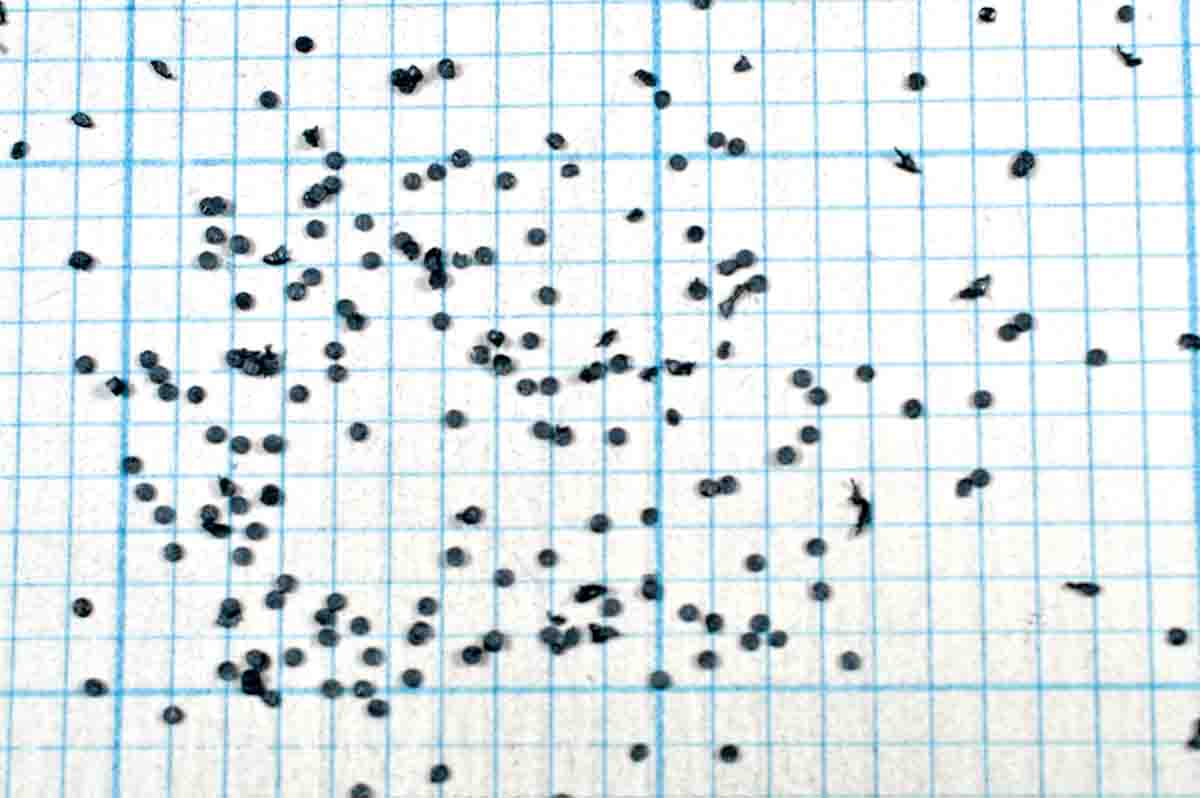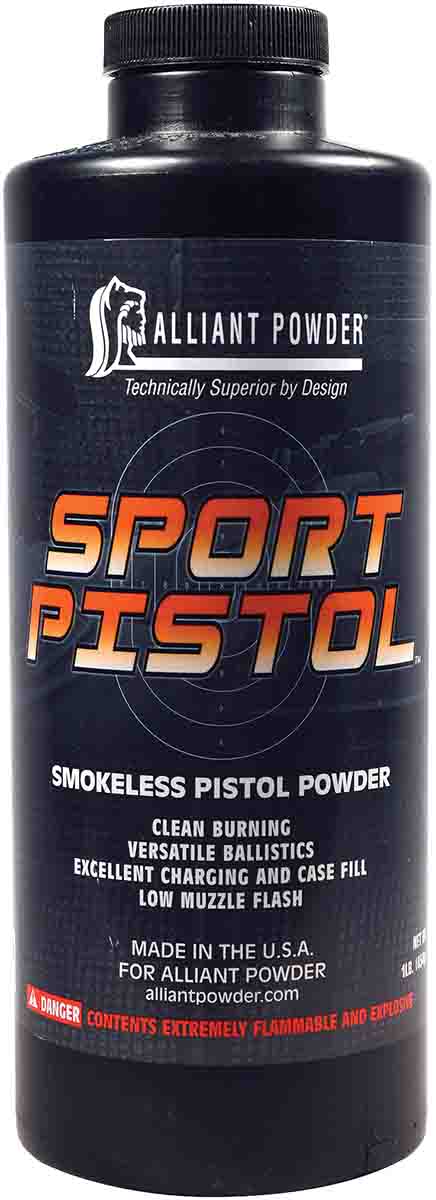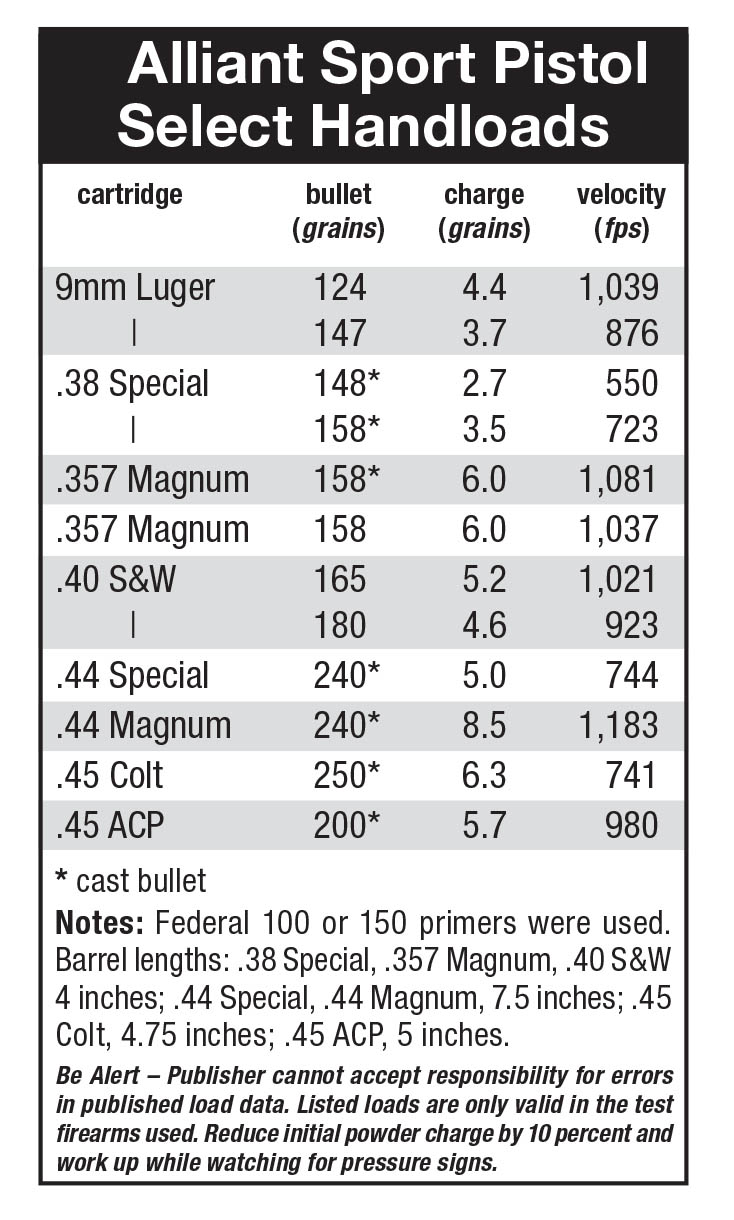Propellant Profiles
Alliant Sport Pistol
column By: R.H. Vandenburg, Jr. | April, 18
Treading the aisles of the annual Shooting, Hunting and Outdoor Trade (SHOT) Show is great fun, made much more so by those stops of particular interest to me as a handloader. One of those stops is the Vista Outdoors area, which encompasses Federal Cartridge, RCBS, Speer, CCI and Alliant Powder, among many other brands. At the Alliant Powder booth in 2017, friend Ben Amonette told me about Sport Pistol powder.
I was handed a new product release and several pages of load data and, later in the year, a couple of canisters of the new powder. Frankly, it took a while for me to get my head around this new propellant. Not in how it is used, which was easy, but its purpose, given that Alliant already makes some of the oldest and most revered handgun powders on the market. I bow to no one in my respect for such stalwarts as Bullseye and Unique, but I have to admit they aren’t the cleanest burning, nor do they meter as well as they might.
A close reading of the product release and talking with Ben finally made it clear. Sport Pistol is aimed at the competitive pistol shooter, whether Bullseye, IPSC, USPSA, IDPA or any of several others. Their commonality is

Sport Pistol qualifies in spades, as it burns very cleanly, meters exceptionally well, is of the right burn rate, exhibits a low muzzle flash and is stable over a wide range of temperatures. In addition to all that, the powder was formulated for use with polymer-coated bullets, a segment of the bullet realm currently enjoying a growing popularity.
To delve more deeply into this powder, note that Sport Pistol is double base with a nitroglycerin content of 10 percent. It is extruded with a diameter of .034 inch and a length, or thickness, of .008 inch. This accounts for its exceptional metering and why it may be more properly referred to as extruded rather than flake, as one might characterize Bullseye or Unique. A medium dark gray in color, the powder has a bulk density of .680 g/cc, giving it a case-filling attribute when used in small-capacity pistol cartridges. Its burning rate is slower than Bullseye, on a par with American Select among Alliant powders and similar to Hodgdon’s Titegroup and Vihtavuori’s N320, among its likely competitors. To the extent such distinctions are possible, Sport Pistol is a pistol powder as opposed to a revolver powder, even though many revolver cartridges are among the early published load data. In those instances the most common pairing is with cast bullets, with plinking or recreational shooting as its likely purpose. The powder is manufactured at the Radford Arsenal facility in southwest Virginia, where all other Alliant flake handgun and shotshell powders are made. Although initially designed as a canister powder, it is already making its mark in the OEM trade in many applications.
Sport Pistol should have the most success in pistol cartridges such as 9mm Luger, .40 S&W and .45 ACP – competition cartridges all – where consistent metering, a clean burn, low muzzle flash and desirable load density are paramount.
I began my review of Sport Pistol with the 9mm Luger. Alliant has load data for the standard-pressure cartridge with a maximum pressure level of 35,000 psi, and in its +P guise. I restricted testing to the former and enjoyed excellent performance with both 124- and 147-grain bullets from Speer.

The .40 S&W was up next with both Sierra 165- and 180-grain bullets. My 4-inch Smith & Wesson Sigma matched the Alliant barrel, and in both instances velocity was just a tick under published data. Accuracy was up to par with that gun and cartridge.
The rest of the cartridges were all presented with cast bullet data. In .44 Special, Alliant used a 5.5-inch Colt SAA. I used my old favorite Ruger Super Blackhawk with its 7.5-inch barrel. Five grains of Sport Pistol under a 240-grain cast bullet exceeded the published velocities by only 7 fps, but overall performance was very good with an impressive extreme velocity spread over five shots of only 17 fps. In .44 Remington Magnum with the same revolver and bullet over 8.5 grains of powder, velocities exceeded Alliant’s published data by almost 100 fps, even though Alliant had used a Smith & Wesson Model 29 with an 8-inch barrel. Stuff happens, but this seems to suggest that as powder charges and bullet weights increase, pressure rises rapidly with this powder. It always does, of course, but the .44 Magnum performance surprised me.
Things were back to normal with the .45 Colt. Alliant used a 5.5-inch Colt SAA to develop the data, whereas I used one with a 4.75-inch barrel. At that, 6.3 grains of Sport Pistol lost only 14 fps to the .75-inch longer barrel. In spite of the cavernous case capacity of the .45 Colt, the combination turned out to be an excellent general-purpose load for the cartridge.
For the .45 ACP, Alliant used its Universal receiver with a 5-inch SAAMI barrel; I used an old Colt Government Model with the same barrel length. Testing was limited to a 200-grain cast bullet, my typical Bullseye and Action Pistol choice. Using 5.7 grains, Alliant Sport Pistol recorded 985 fps; I clocked 980 fps. Close enough. Accuracy was up to par from this gun.
Wrapping up, I’m impressed with Sport Pistol in the smaller-capacity pistol cartridges – its intended home – and it seems Alliant has met its intended goals. As a recreational choice for most revolver cartridges, I suspect it will frequently find a home there as well. While published load data was fairly extensive for a new handgun powder, I’m sure the future will find it being used in many more catridges, both pistol and revolver. Sport Pistol is available in one-, 4- and 8-pound containers.



